
A Quiet Walk to Remember
Words Anutra Ungsuprasert
Photos Thalay Thammapakkul, Anutra Ungsupraset, Shutterstock
They say life is slow in Luang Prabang. You can’t imagine how slow until you get there. This lovely UNESCO World Heritage city, and a former Lao capital, still stands regal in its peacefulness – the way it’s been for many years.
My visit to Luang Prabang last September – rainy and not quite satisfactory – meant a return trip to this sunny land was required. But another reason that pulled me back was missing the elephant sanctuary on my last trip. I was told the slow, meditative communion with these large giants somehow fits well with Luang Prabang’s mood. So several months later, I head back, determined to walk shoulder to shoulder with the elephants.
Staying at Rosewood Luang Prabang property, a 10-minute drive from town, is very relaxing. It feels like being in one of Rudyard Kipling’s adventures. The resort is nestled in a lush forested valley split down the middle by a waterfall and the river it feeds. All rooms are named after a famous person with a historical connection to Southeast Asia, and a view of the Nam Dong river. You hear its dancing flow while crickets chirp and birds sing.
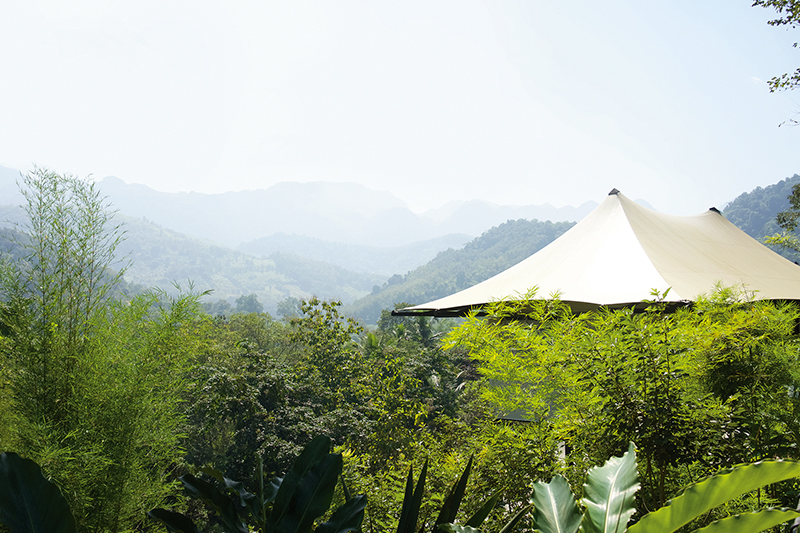

Later, I walked to the higher point of the property where hilltop tented rooms sit. The luxurious white glamping tent-design rooms afford an impressive view of the property, evoking a sense of camping in the woods. What it’s like being a real explorer? To sleep in the woods, or simply stay radically basic like our ancestors? I dream on and wonder what it was like when this land was once called Lanxang, the land of a million elephants. I envision kings riding on the majestic animals as their ‘workhorse’ during the war.
Nowadays, only about 400 exist in the wild, and another 400 to 500 in captivity. But a non-profit organisation aims to increase the elephant population in this country. The “Lao Elephant Initiative” is a collaboration between Michael Vogler, an Environmental Sciences graduate from Portland State University in the USA along with his friend, and a veteran elephant expert from Thailand, Mr. Prasop Tipprasert. All share a passion for wildlife preservation, with Mr. Prasop having worked in Thailand’s elephant population for 27 years with his pioneering project at Chiang Mai University.
Nicknamed “Jane & Tarzan” in Thailand, the programme reintroduces elephants to each other in a natural environment. They send “Jane” into the jungle where she finds “Tarzan”, they honeymoon for 2 months and hopefully have a baby. After 2 and a half years in a sanctuary, the elephants are sent back to the jungle – a national park or “university”. The mission in Laos is the same, to increase the number of elephants.
But before I visit the elephant sanctuary, I touch base with historic Luang Prabang. Staying near the Nam Khan river, I grab a hotel bike and go into the historic district, passing the 100-metre-high Mount Phousi on my way, the most popular hiking summit for sunrise and sunset views with the golden temple of Wat Chom Si at its top. At the foot of the hill sits the Traditional Arts and Ethnology Centre which exhibits the district cultures of various ethnic groups. Next to it is the famous gilded Wat Xieng Thong, dating back to the 16th century.
I paddle along the riverside where Nam Khan meets the Mekong. From there I make a stop at the Luang boat pier, rather than cross the Mekong river to Pak Ou Caves packed with more than 4,000 Buddha images, I take a boat to see Xangkhong village and their handicraft products. Apart from disappointing touristy craft shops, the boat ride isn’t that bad. I have a chance to gaze at life along the river, watching the fishermen’s catch of the day and water buffaloes working the rice fields.

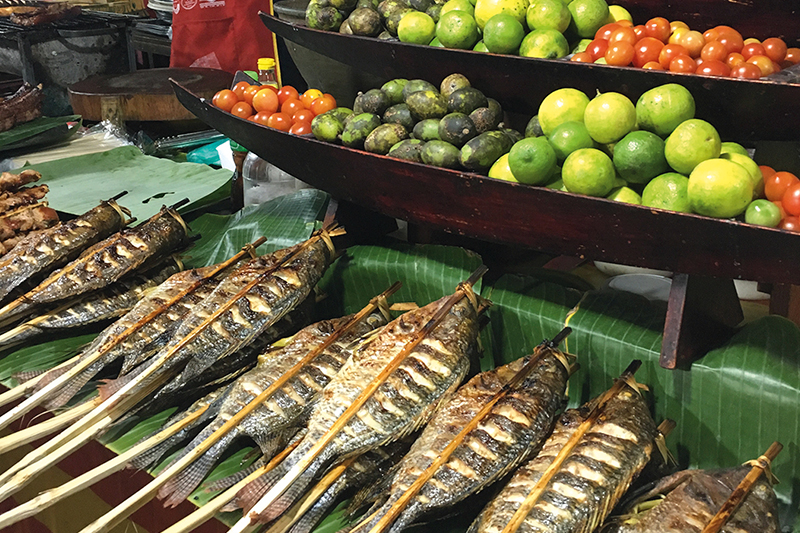
When my stomach grumbles, I give Bouang restaurant a try, with its fusion Laotian food. The restaurant is located almost at the end of the Sisavangvong Road where rows of restaurants lie. The food at Bouang is pretty lovely and delicious. They have their own version of Mango Sticky Rice – different from Thailand and elsewhere – they use purple sticky rice cooked in coconut milk, rolled in black & white sesame and fresh grated coconut.
I ride back down the restaurant lane where I enter into a small entrance of an old temple sitting behind bar and restaurant shop houses next to Wat Siphoutthabath temple. Inside, a group of young novices work and restore the walkway. Other people dry hundreds of pieces of white flour on bamboo covered with newspapers. “It’s called Khanom Khee Noo (fried flour snack) that you see selling on streets. After the flour batter is deep fried, they will be golden, sweet, and a bit salty, crispy,” the snack vendor guarantees.
I go back to my favourite night market. Last time, I bought some interesting cloth wristwatches made from handmade strips and beautiful graphically textiles. Even though it looks pretty much the same, but there is some thing that draws people to come back – the atmospheric lighting, the smell of street food and people’s laughter.
This time, I’m drawn into a small alley, the first one on the left when you cross the road from the post office. It is jam-packed with local food stalls – grilled Mekong fish, pork ribs, chicken and papaya salad. It was surprisingly unattractive with a black papaya that was longer and wider than what I know. Its appearance may have looked good, but there’s no telling with the taste! Everything, especially the pork ribs are made fresh, juicy and grilled medium well. mouth-watering indeed.
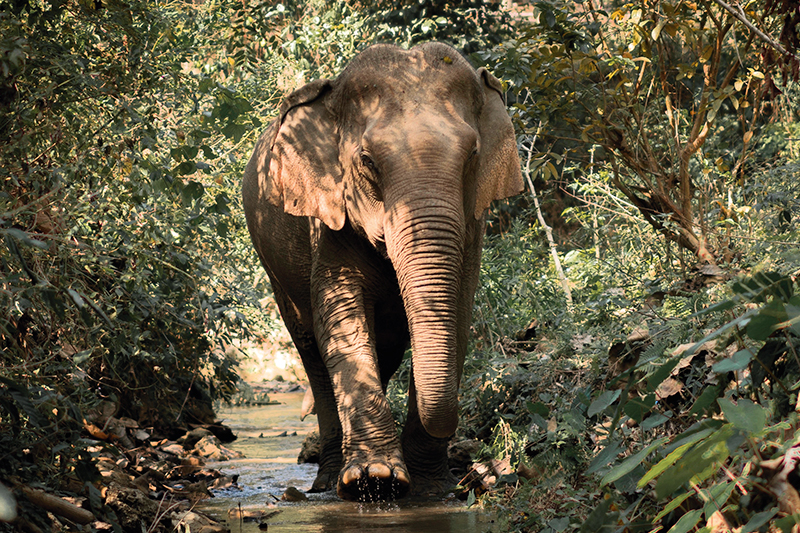

Anyway, I keep the best for last – my big day with the elephants. I wake up early in the morning and our local guide takes me and nine other people in van. Only 30 minutes away is MandaLao, the non-riding elephant sanctuary. As the name suggests, guests aren’t given any chance to ride on the calm creatures.
MandaLao just turned two years old, founded by an American, Michael Vogler. He and his friend moved to Laos and started eco-tourism activities under “MandaLao Tours” and at the same time save the elephants with the “Lao Elephant Initiative”.
Recently, there are 9 elephants at the sanctuary – 8 females and a 2 and a half years old male, named Mr. Kit or Mr. Tarzan Junior, who was born through the reintroduction programme.
Mr. Prasop, the Thai elephant conservationist, told us the orientation, “No babies, no future. I helped the elephant population in Thailand increase by 7% each year. I want to do the same in Laos.” For Mr. Prasop, saving these animals is not just for the animals themselves.
“I cannot just say, please save the elephants because they are cute. They bring us rain, oxygen, reduce global warming, etc. Each of them eat 200-250kg every day and return more than half of the nutrients back to the ground. They eat for us – they make the ground more fertile, and the fertile soil gives us food,” he said, before sending all of us to join the elephants in the sanctuary.
Ten of us are taken on a boat crossing to the other side from the reception point. A few minutes later, we found ourselves standing, feeling so tiny, close to 3 elephants-43-year-old Kham, 50-year-old Marn, and 43-year-old Pheng – with loads of bananas. We begin to assess each other, but they just love us because we have tons of bananas for them.

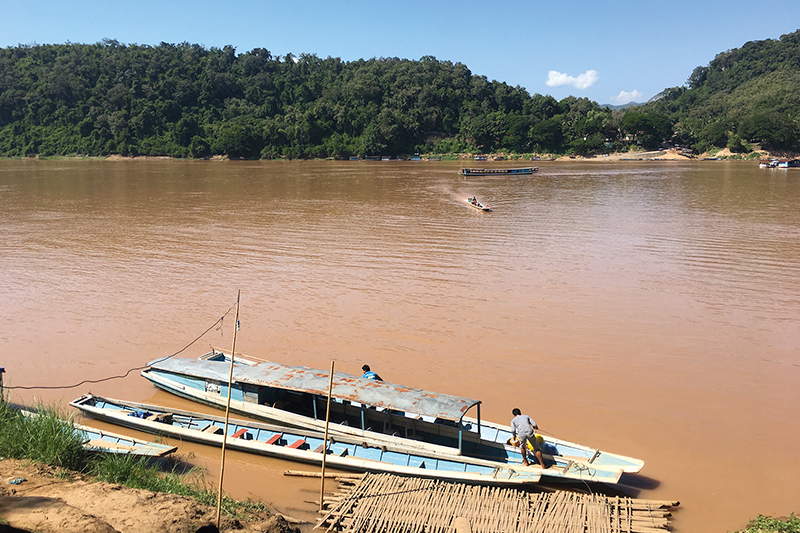
Over the next 3 hours, we walk with the elephants and their mahouts in the jungle. We need to lead and the elephants follow – this is to avoid them stomping on our feet. We go side by side quietly at the same speed – about 3 to 4km per hour – feeling very much in touch with nature and with these awe-inspiring beasts. The elephants walking through the forest naturally with nothing on their backs makes you really feel they are truly wild, and independent creatures.
“They love touching, hugging and kissing, but avoid the burn and tail. They don’t like it. Touching their head, ears, trunk, it’s okay,” instructs the guide.
Along the way, the 3 elephants make many stops to eat their favourite food which is wild creepers. We can tell that these elephants are happy as they flap their ears and swing their tails.
Joining this activity in the middle of the jungle gives me such peace of mind, and respect for nature and fellow beings. And yes, Mr. Prasop is right. “Not riding [the elephants] is not everything,” he says. “It is nothing if you don’t care about the welfare of these elephants. And to make this work, you cannot just do it only in one country. Now I’m working with many friends to build a network within Cambodia, Thailand, Myanmar, and Laos called the ‘Trans-boundary Wildlife Conservations.’ These elephants don’t care if they are Thai or Lao as long as they have bananas.”
Getting there:
Bangkok Airways has a direct flight from Bangkok to Luang Prabang – one flight per day; and 3 flights per week (Tuesday, Thursday and Saturday) from Chiang Mai, Thailand to Luang Prabang, Laos PDR.
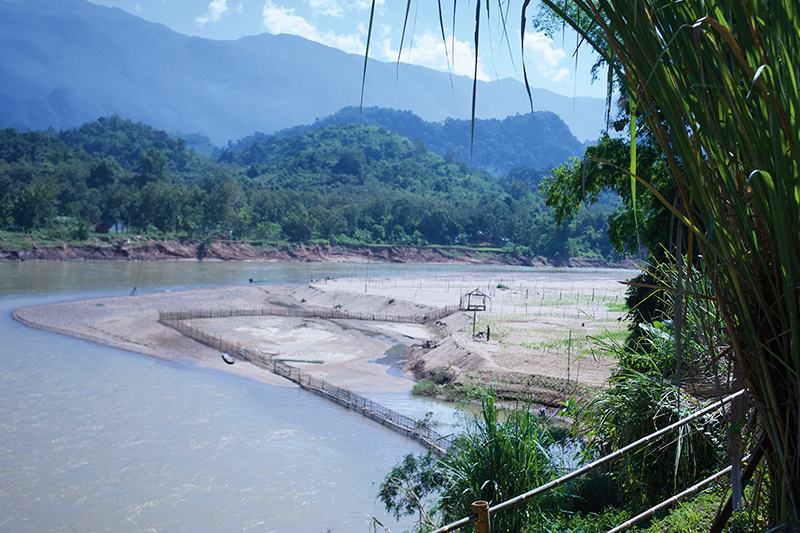
หลังจากพลาดไปเยือนศูนย์อนุรักษ์ช้าง MandaLao เมื่อคราวก่อนเพราะฝนตก ทริปหลวงพระบางสามวันสองคืนครั้งนี้เราต้องไม่พลาดอย่างคราวที่แล้ว วันแรกเราพักที่ Rosewood ขับรถออกมาจากตัวเมืองเพียง 10 นาทีเท่านั้นก็จะพบกับรีสอร์ตที่ห้อมล้อมด้วยป่าไม้ ขุนเขา มีน้ำตกและแม่น้ำดงตัดผ่าน เสียงกระแสธารเริงระบำ จิ้งหรีดร้องเซ็งแซ่ มีนกส่งเสียงคลอเป็นแบคกราวด์
เดินขึ้นไปตามเนินของรีสอร์ต มีห้องเต้นท์หรูอยู่บนยอดเนิน ทิวทัศน์ที่สวยสะกดทุกลมหายใจ ทำให้นึกถึงตอนที่ดินแดนแห่งนี้มีชื่อว่าล้านช้าง ซึ่งแปลง่ายๆ ว่า ดินแดนแห่งช้างล้านตัว
วันต่อมาเรากลับเข้ามาพักที่โรงแรมใกล้แม่น้ำคาน เพื่อซึมซับประวัติศาสตร์ของหลวงพระบาง เราขี่จักรยานของโรงแรมเพื่อเข้าเขตเมือง ผ่านยอดเขาภูสีที่ตั้งวัดทองคำชมสี แล้วมาชื่นชมความงามของวัฒนธรรมกลุ่มชาติพันธุ์ที่ศูนย์ศิลปะพื้นถิ่นและชาติพันธุ์วิทยา และเยี่ยมชมวัดเชียงทองที่สร้างตั้งแต่ศตวรรษที่ 16
จากนั้นนั่งเรือจากท่าเรือหลวงไปยังหมู่บ้านช้างโขงเพื่อไปชมงานฝีมือชาวบ้าน เลยช่วงโค้งน้ำที่แม่น้ำคานบรรจบกับแม่น้ำโขง แต่ก็ผิดหวังกับงานพื้นๆ และร้านรวงที่รองรับแต่ทัวริสต์ อย่างไรก็ตาม ได้นั่งเรือชมวิวก็ดีเหมือนกัน ได้เห็นชาวบ้านจับปลา ควายไถนา ท่ามกลางภูเขาเขียวขจี
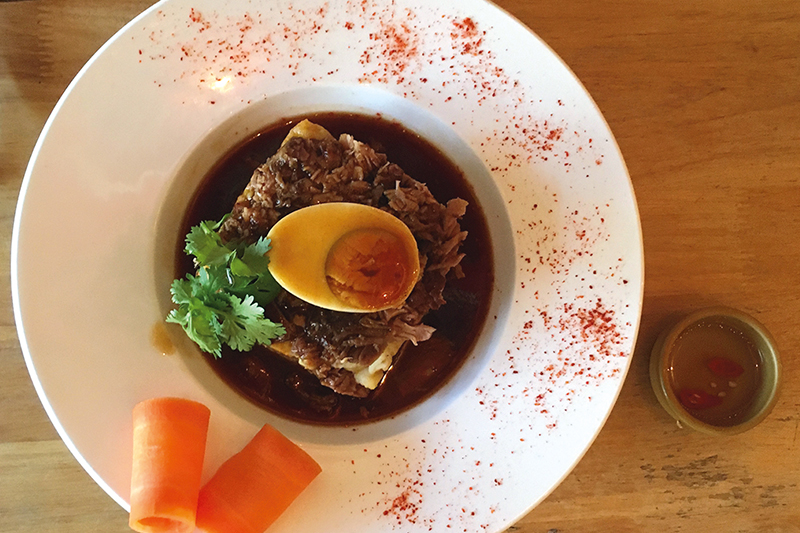
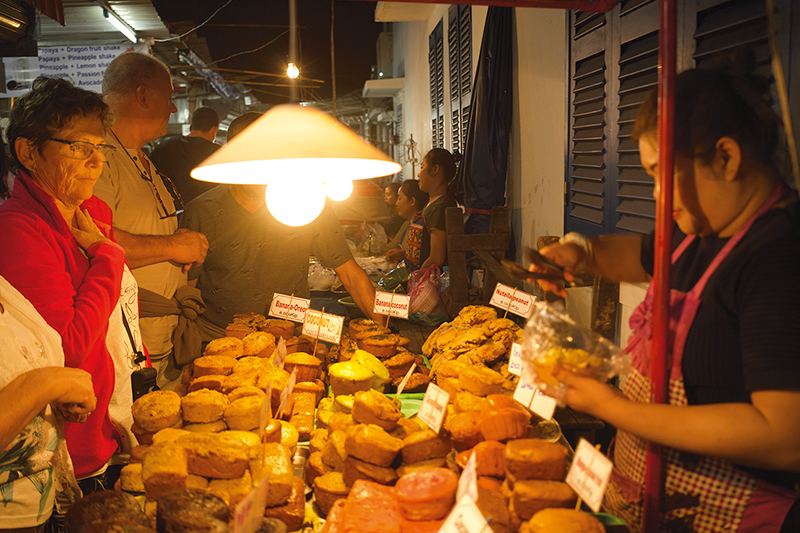
ขึ้นฝั่งก็ได้เวลาอาหาร ร้านบวง (Bouang) ร้านอาหารฟิวชั่นลาว ตั้งอยู่เกือบสุดถนนศรีสว่างวงศ์ ติดใจรสอร่อยของแหนมข้าวและข้าวเหนียวอัญชันมูน มะม่วงหวานราดกะทิ โรยด้วยงาคั่วและเนื้อมะพร้าวฝอยแล้วเดินต่อไปยังพระบรมมหาราชวังและพิพิธภัณฑ์ประวัติศาสตร์
ก่อนอาทิตย์ลับของฟ้า ขี่ย้อนกลับมาทางเดิมแล้วแวะที่วัดสีพุดทะบาด เห็นเณรน้อยกวาดทางเดินในวัดและชาวบ้านตากขนมขี้หนูที่นำมาทอดเป็นสีเหลืองทอง หวานนิดเค็มหน่อย กรุบกรอบเป็นขนมทานเพลินๆ
ตกค่ำ ขอแวะตลาดกลางคืน เพราะมาเมื่อไรก็ไม่รู้เบื่อ กลิ่นอาหารหอมฉุยพร้อมกับเสียงหัวเราะของผู้คน พร้อมงานหัตถกรรมของลาว ภาพเดิมๆ นี้แหละที่ดึงดูดนักท่องเที่ยวกลับมาสัมผัสหลวงพระบางครั้งแล้วครั้งเล่า
ครั้งนี้ เราเลี้ยวซ้ายเข้าตรอกตรงข้ามไปรษณีย์ที่เป็นแหล่งสตรีทฟู้ดลาวโดยแท้ ทั้งปลาน้ำโขงปิ้ง ไก่ย่าง ส้มตำ ซี่โครงหมูย่างฉ่ำๆ เราลองทั้งหมดนั่นด้วยความเอร็ดอร่อยเหลือเชื่อ
ไฮไลต์ท้ายสุดของทริปอยู่ที่ MandaLao Elephant Sanctuary นั่งรถตู้ไปพร้อมกับอีก 9 ชีวิต เพียง 30 นาทีจากที่พัก อดใจรอทักทายเจ้าช้างเพื่อนแก้วไม่ไหวแล้ว
MandaLao ดำเนินงานมากว่าสองปีแล้ว Michael Vogler หนึ่งในผู้ก่อตั้ง หลงใหลในการอนุรักษ์สัตว์ป่า ตัดสินใจมาอยู่ที่ลาวเพื่อริเริ่มการท่องเที่ยวแบบอนุรักษ์ธรรมชาติภายใต้ชื่อ MandaLao Tours พร้อมกับก่อตั้งองค์กรที่ไม่แสวงหาผลกำไร Lao Elephant Initiative เพื่อเพิ่มประชากรช้างซึ่งเหลือเพียง 400 ตัวในป่า และช้างเลี้ยง ที่ขณะนี้เหลือเพียง 400-500 เชือกเท่านั้น
Michael Vogler ได้พบกับคุณประสพ ทิพย์ประเสริฐ นักอนุรักษ์ช้างไทยที่ทำงานมากว่า 27 ปี เขาตั้งใจว่าจะพยายามเพิ่มประชากรช้างในลาวให้ได้เหมือนกับที่ทำสำเร็จในไทยมาแล้ว
คุณประสพกล่าวว่า เราคงพูดไม่ได้หรอกว่ามาช่วยช้างกันเพราะความน่ารักของมันเพียงอย่างเดียว แต่อาหารที่ช้างกินกว่า 200-250 กิโลกรัมต่อวันเปลี่ยนเป็นมูลที่เพิ่มความอุดมสมบูรณ์ให้กับผืนดินในป่าอีกด้วย
ไกด์ของเราแจกเป้กันน้ำ ขวดน้ำ และรองเท้านินจาบูทยาวเพื่อกันยุงและโคลน เราทั้ง 10 คนนั่งเรือไปอีกฟากเพื่อทักทายช้างใหญ่ 3 ตัวที่ทำให้รู้สึกได้ทันทีว่าเราตัวเล็กนิดเดียว เราเริ่มทำความคุ้นเคยกับช้างด้วยการป้อนกล้วยจำนวนมากที่เตรียมไว้เชื่อมสัมพันธ์
เราเดินป่าไปพร้อมกับช้างเป็นเวลา 3 ชั่วโมง เดินไปด้วยกันในจังหวะเดียวกันและสัมผัสธรรมชาติร่วมกัน นี่สินะคือช้างป่าที่ใช้ชีวิตอย่างอิสระอย่างที่ควรจะเป็น
การที่ได้ทำกิจกรรมกลางป่าแบบนี้ทำให้จิตใจสงบ ทำให้เราเคารพธรรมชาติ คุณประสพพูดถูกแล้วที่ว่า การไม่ขี่ช้างเป็นแค่ส่วนหนึ่ง ถ้าเราไม่ดูแลช้างอย่างดีก็ไม่มีค่าอะไร และเราจะทำแค่ประเทศเดียวไมได้ เราต้องสร้างเครือข่ายอนุรักษ์ช้างในกัมพูชา ไทย เมียนมา และลาว ช้างไม่สนหรอกว่าตัวเองชาติไหน ตราบเท่าที่มีกล้วยให้พวกมันกิน
การเดินทาง:
บางกอกแอร์เวย์ส มีเที่ยวบินตรง กรุงเทพฯ-หลวงพระบาง หนึ่งเที่ยวบินต่อวัน และเที่ยวบินจาก เชียงใหม่-หลวงพระบาง 3 เที่ยวบินต่อสัปดาห์ (อังคาร พฤหัสบดี และเสาร์)
